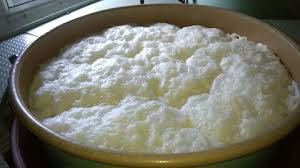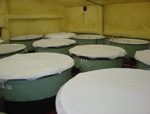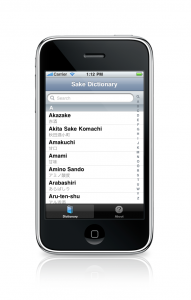|
|
|
Cherry-blossom Greetings to all readers,
Spring is here - it is official in every way!
Greetings,
It is all official now! The spring equinox has come and gone, and we are in that half of the year in which the days are longer than the nights. April is full of sake events as 'tis the season to show off the new stuff. As I write this, the cherry blossoms are in full bloom - a gorgeous site that will be gone in but a day or two, reminding us all of how delicate all things are.
There are lots of nama-zake and other seasonal fresh sake to be enjoyed! Even if there are no major sake events near you, get your hands on some great nihonshu and relish the season!
Please enjoy the newsletter, some sake with it, and keep warm in the chilly spring, where ever you are.
John Gauntner
~~~~~~~~~~~~~~~~~~~~~~~~~~~~~~~~~~~~~~~~~~~~~~~~~~~
Sake Today - the Magazine
Look for the next issue due out in June! And, look for a subsciption service to be set up very soon.
I am exuberantly pleased to announce that Sake Today, the world's first English-language
printed sake magazine - is now available!
The inaugural issue of Sake Today is full color on high -quality A4-sized paper with an extra-thick cover and glued-in spine. It is 60 pages of well-written articles from experts in the field, beautiful photography and more. It is the world's first and only English-language sake magazine, founded by myself (John Gauntner) and publisher Ry Beville.
Read articles from sake industry luminaries like Haruo Matsuzaki and Chieko Fujita, as well as pottery specialist Rob Yellin, and the other usual suspects of the sake world. There is something in Sake Today for any fan of sake.
We are not yet set up for subscriptions but order your copy today for 700 yen (about $7) here. Check it out!
~~~~~~~~~~~~~~~~~~~~~~~~~~~~~~~~~~~~~~~~~~~~~~~~~~~~~~~
Sake Confidential - due out in June!
I am pleased to also announce that my next book - my sixth - will be in bookstores in June. Sake Confidential is a beyond-the-basics guide to the sake world, and after a short introductory chapter on all things sake, it goes into depth on many topics not usually touched upon.
Sake Confidential is a practical and concise yet complete guide to sake idiosyncrasies, misperceptions, and controversies presented in a conversational and informal tone. Easy to read and frank, it also includes sake recommendations tied into each of the topics presented.
You can reserve yours here at Amazon. In the meantime, look for more concrete information about where to get it as soon as that becomes available.
|
|
Koshiki-taoshi and Kaizo
The light at the end of the sake-brewing tunnel
It was well into the evening when the phone rang, but my caller i.d. told me the call was from a brewer in Akita Prefecture. Since he fits into both the friend and business associate categories, I picked it up.
"Du-hu-hu-hu-de. I'm pretty ha-a-a-a-mmered." Not your typical call from the owner of a prestigious sake brewery, to say the least.
And to what do I owe this honor? Surely there must be a reason you have called at this hour and in this, er, state?
Indeed, indeed. Today was 'kaizo.' It's over. We are done for the season.
 |
|
That's it. Kaput! All we have to do is clean up and we are outta here until the fall." He seemed to momentarily forget he lived in the old house attached to the kura. "And, thanks to your support," he continued with typical Japanese uber-humility, “we managed to finish the brewing season this year without any major difficulties.” I was fairly sure I myself had nothing to do with that, and of course politely deferred.
"Wow," I responded. "That's great. Congratulations. Another season down! I am sure you are relieved, and I am just as sure your sake will be kick-ass again this year."
The true reason behind their call, driven though it was by the unbridled exuberance of the "kaizou" party, was to thank me for a positive assessment of a new sake they came out with that I was fortunate enough to have been able to taste several days earlier. I had recently ran into the two of them by coincidence, armed with a bottle, at a sake pub the night before a big Tokyo tasting. Regardless, it was great fun to hear from them, and congratulate them on completing the season.
"Hold on. There is someone here that wants to talk to you." The cell phone got dropped at least twice and bashed into something made of glass on its way to whomever it was destined. Things like that happen in a room full of happy, buzzed sake brewers. Actually, I knew who it was going to be before I even heard the familiar voice.
"Du-hu-hu-hu-de. I'm pretty hammered too-hu-hu-hu." It was the relatively young toji (master brewer) at that kura. "We made it through yet another season. And thanks to your support, we finished without a hitch…"
It was fun to hear from them, late though it might have been, and they certainly deserved to celebrate.
 |
|
As many readers certainly recall, sake brewing runs roughly from the fall until the spring. Just when a kura begins to brew sake and when they finish for the year depends on a number of factors, including of course how much they brew. On top of this, dynamics including the number of brewers, number of tanks, size of the batches, how old or new their equipment is, and how often they fire up a new batch will all combine to determine just when they start and end. But typically it runs from mid-October to mid-April.
As the season draws to a close, there are two significant days that the people in the brewery owners and brewers together will celebrate. One is called "koshiki-taoshi," the other is "kaizou."
"Koshiki-taoshi" means "overturning the rice steaming vat." A koshiki is the large vat in which rice is steamed every morning or so. In days of olde, the koshiki was made of wood (sugi, i.e. cryptomeria) and sat on top of a large iron cauldron of water (called a wagama) that tapers at the top.
Today only a handful of kura use wooden koshiki anymore. The craftsmen to make them are also all but gone. Most are steel these days, and in fact, many are fully automatic. Long ago, when the last vat of rice had been steamed, the koshiki would be turned over onto its side, cleaned thoroughly, and left to dry and be put into storage until next season. This is the term to which koshiki-taoshi refers.
When the last batch of rice has been steamed for the year, the brewers can see the light at the end of the brewing-season's tunnel, hence the celebratory nature of the day.
 |
|
Of course, that last day's vat of rice will then be added to the last tank still fermenting, and after that there is still three weeks or more of waiting for those last few batches to finish fermenting, and then be pressed and sent to mature for a while. So their work is far from done. Koshiki-taoshi means only that there is no more rice to be steamed. Within two days, there will be no more koji to be made, and soon after that it is simply a matter of waiting. They know they are getting close to the end of six months or more of long, hard days.
Often in these modern times, automated koshiki are equipped in such a way that they can be turned sideways to make it easier to scoop out the rice. Kinda makes knocking them over a bit anticlimactic. Also, large brewers have continuous rice steamers, large contraptions that steam rice as it moves along on a mesh conveyor belt over steam, and constantly crank it out. So at such places there is no koshiki to knock over. But nonetheless, a ceremony and small party are held to acknowledge the significance of the last steaming of the season.
The next milestone is “kaizo.” “Kaizo” is written with characters that mean "all (has been) made," and naturally enough indicates the day on which the last tank has been pressed, and therefore all the sake for the year has been brewed. All there is left to do is to sweep up, tidy up, and pack up.
After one or the other - or perhaps even both - of these significant days, the brewers and other employees of a sake brewery will often have a little bash in the kura. The kuramoto (brewery owner) will prepare a nice dinner, there will be warm toasts to each other, and there will be plenty of sake consumed. Also, newly made sake is offered to the gods in thanks for the blessings of the brewing season.
While, from what I have heard, it is more common to have this little party after koshiki-taoshi, obviously the folks at some places (like my friend in the intro) wait until kaizo, when presumably they can sleep late the next day.
Back in the 1960s when several of the larger kura rode continued growth to mammoth-hood, they began to brew all year round, in what is called "shiki-jozo," or "four-season brewing." However, as sake consumption has dropped off, especially that of cheap sake, the need for year-round brewing has dropped off, and none of the big brewers are doing this any longer.
 |
|
But interestingly, there are a handful of smaller brewers that brew basically all year, freezing the rice for use in the summer, and brewing at a more manageable, mellow pace. This pace might be starting a batch once or twice a week rather than everey day. Just when these places celebrate koshiki-taoshi is not clear. But I am sure they work it in somewhere!
|
|
Sake Industry Snapshot
As we enter into a new fiscal year, here is a snapshot of the current state of the sake industry.
 |
|
Statistics, as we all kow, are, well, statistics. They can be bent to one's purposes, but the other side of that coin is that if one just wants to know the truth, statistics are often useless. So take these with a very small grain of salt. In fact, take them with a sodium nitrate molecule. That's plenty.
Sake sold in Japan last year was down –
again! – 3.8 percent. The volume given was 574,000 kiloliters. Most regions were down, but Kyoto and Niigata were up a bit.
However: ginjo sake was up a whopping 12 percent! Junmai-shu was up 2.2 percent. Honjozo was down 6.3 percent and futsu-shu (non-premium) sake was down 5.8 percent. When the largest chunks of the market drop significantly, the overall market drops, regardless of how well the premium stuff is selling.
So, what we have is a situation in which people are drinking more and more premium sake, and less non-premium.
Sake dropped to about six percent of all alcohol consumed in Japan. That needs to be turned around, and fast!
 |
|
The number of brewers dropped –
again! – but this year we only lost nine, so we are down to 1251 remaining kura. However, 57 percent of those companies lost money or had very minimal profit from selling sake alone. But note that many companies augment their sake sales revenue with other business activities. That number of but six percent must change as well!
But all is not lost; far from it! Sake seems to be making a comeback, although only time will tell if it has momentum or not. Sake overall was up 5.3% in January over the same period last year, and ginjo alone was up a significant 26.8 percent. What can we make of this? You make that call. As I said, statistics can be misleading.
Note to that exported sake is not included in these numbers; it is just the way the government keeps statistics. Exports continue to grow at roughly ten percent a year, but still add up to about only two percent of all sake brewed. Plenty of room for growth there!
What can you do? Drink more sake, and convince your friends to do the same! No need to pay attention to anything else. Increased appreciation of sake will solve 80 percent of the problem!
|
 Announcements and Events Announcements and Events
Sake Professional Course in the US
August, 2014
The next Sake Professional Course will most likely be in Chicago Ill in
August. While the final dates and venues are being hammered out now, by all means, should you be interested, please send me an email to that purport.
The Sake Professional Course will of course include certification testing for the Sake Education Council-backed Certified Sake Professional exam.
~~~~~~~~~~~~~~~~~~~~
Sake Education Council Website
Please take a moment to check out the website for the Sake Education Council, the organization behind the Certified Sake Professional and Advanced Sake Professional certifications. We plan to grow steadily, strongly and continually, and we will need the support of all those that love sake to do so. Follow us through the "usual suspects" of social media.
Don't forget the archives!
Older editions of this newsletter are archived here.
Really old editions are archived here.
|
 Sake Education Central Sake Education Central
Sake's Hidden Stories and The Sake Notebook are now available for the Kindle, Nook and iBooks!
The Sake Notebook is now available for the Kindle as well as the Nook. And now, it is available for iBooks on iTunes as well!
Sake's Hidden Stories too is now availabe on the Kindle as well as the Nook. And now, it is available for iBooks on iTunes as well!
Both are
less expensive than their original pdf version too. Now is your chance to learn more about sake from your phone or tablet! Check 'em out!
Sake Dictionary App for the iPhone, iPod and iPad
"For 99 cents, this app ROCKS!!"
-a satisfied customer
There you are, perusing a menu, or standing in front of a shelf of great sake, or perhaps reading a sake newsletter… and up pops one of those hairy, pesky sake terms in Japanese. You know you have heard it many times, but dammit, you just cannot remember what it means now…
No problem! Just whip out your iPhone or iPod and fire up your trusty old version of
The Sake Dictionary. In a matter of seconds, you’ll be amongst the cognoscenti once again. But… if only you could pronounce it properly. Now that would really rock!
Done! Just tap on the term and you will hear a clear example of how to pronounce the term in Japanese. Repeat it a couple of times and the term is yours for eternity, to toss about and impress your mates.
What’s more, it’s
less!
Less than what it cost before, much less. Like less than one-seventh less. For a limited time only, the audio-enhanced version of The Sake Dictionary iPhone app is available for a mere $0.99.
|
 |
|
|
The Sake Dictionary is a concise little package of all the terms you might ever come across when dealing with sake. Almost 200 of them - including sake grades, rice variety names, seasonal sake terms, special varieties, rare types, post-brewing processing words and the myriad terms used in sake production - many of which are not even familiar to the average Japanese person on the street - are listed up here with concise, useful and clear definitions and the written Japanese version as well. And now, with the new audio component, you can listen and learn just how to pronounce those terms properly.
Start to toss around Japanese sake terms like you were raised knowing them! Gain a level of familiarity hitherto unimaginable! Avoid frustrating paralysis when faced with a sake-related purchase!
Get your copy of The Sake Dictionary now and never be confused by sake terms - or how to pronounce them - again.
Get it here: http://itunes.com/apps/sakedictionary
(Note if you have already purchased it, this upgrade to the audio version is free. Just go to iTunes and get it!)
|
Are you not getting this newsletter? I realize that is like asking that
"those not present please raise your hand," but for future reference, should you spontaneously stop receiving this newsletter, please go here and sign up again. Should that not work, please go to www.sake-world.com.
Email newsletter services are very careful not to be considered spam enablers, but the problem is that often very valid email addresses come back bounced as invalid. It is an unavoidable problem. So if you or someone you know is not getting this, or stop(s) receiving it inexplicably, please do take a moment to double check that you are still subscribed.
Sincere apologies for the hassle, mixed with gratitude for reading this newsletter. |
I hope you have found the above information helpful and entertaining. For more information about all things sake, please check out www.sake-world.com. Until next month, warm regards, and enjoy your sake.
Questions and comments should be directed to John Gauntner, at this
email address.
All material Copyright, John Gauntner & Sake World Inc.
Regards,
John Gauntner
Sake World, Inc
 . . 
|
|
